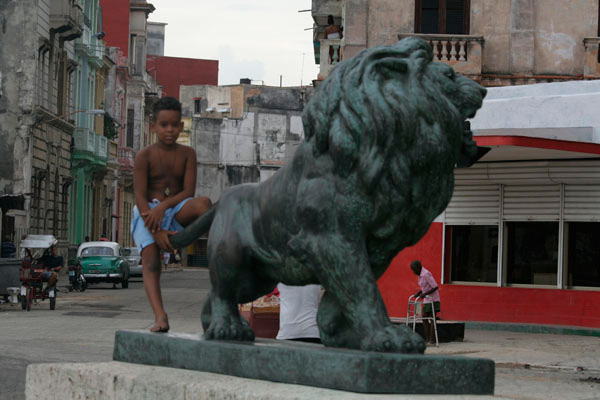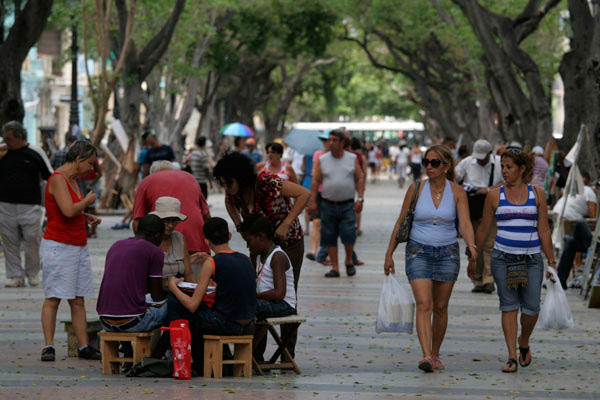Havana’s Prado Promenade
Photo feature by Elio Delgado Valdes
Text by Elvira Pardo Cruz
HAVANA TIMES — In these days of intense heat – when thermometers register temperatures above 30º C – residents of Havana go out in search of places where they can evade the scorching sun.
The city’s majestic Prado promenade invites strollers to rest and give in to the day’s weariness. Fleeing the stifling heat, I went in search of some respite, like many others, towards the benches of the welcoming tree-lined avenue, where I was able to get some rest. Little by little, the breeze appeased my senses, overwhelmed by the heat, and, in the new-found calm, I was able to appreciate all of the details of this legendary place. Our daily haste can often blind us to our surroundings, to the treasures of the city’s architecture most of all.
 Extending from the ocean drive to Old Havana’s Fuente de la India (“Indian Fountain”), the Prado promenade, the first such avenue built outside the city’s fortified walls, began to be constructed in 1772 as an initiative of the Marques de la Torre. It was later improved by Luis de las Casas and the Count of Santa Clara. General Tacon is responsible for its subsequent broadening. The promenade was also modified to accommodate the construction of Old Havana’s Parque Central, Parque de la Fraternidad and the renowned Capitol building.
Extending from the ocean drive to Old Havana’s Fuente de la India (“Indian Fountain”), the Prado promenade, the first such avenue built outside the city’s fortified walls, began to be constructed in 1772 as an initiative of the Marques de la Torre. It was later improved by Luis de las Casas and the Count of Santa Clara. General Tacon is responsible for its subsequent broadening. The promenade was also modified to accommodate the construction of Old Havana’s Parque Central, Parque de la Fraternidad and the renowned Capitol building.
The Prado promenade is characterized by a neo-classical designs. It boasts marble benches beset by sculpted cups and is illumined by street-lamps adorned with mythological motifs. At all four corners of each of the avenue’s sections, we find bronze lions, seemingly custodying the surroundings, authored by French sculptor Jean Puiforcat and Cuban-born master caster Juan Comas, who used the metal from decommissioned cannons to forge the creatures.
The promenade, today the venue of the Imagen Tres (“Image Three”) Project – centered on music, visual arts ad graphic design – is a highly active place. There, young people and adults participate in art workshops and attend exhibitions. Artworks are sold and visual artists, photographers, sculptors and craftspeople gather there, among the constant traffic of passersby.
 People looking to swap or sell homes meet in the stretch of avenue between Colon and Malecon streets. Gathering beneath the vegetation there to shield themselves from the merciless sun, they come from distant places in the city to review the options available.
People looking to swap or sell homes meet in the stretch of avenue between Colon and Malecon streets. Gathering beneath the vegetation there to shield themselves from the merciless sun, they come from distant places in the city to review the options available.
In other areas, young people ride their skateboards or carts, performing complex and intrepid moves.
The atmosphere is enlivened by the sounds of passing cars, the street cries of vendors selling snacks and the warbling of birds who have settled in the canopies of the trees that line the promenade.
The Paseo promenade is a place full of memories and longings. For those here and abroad, it will continue to be – like its lions – a silent witness of time.
Click on the thumbnails below to view all the photos in this gallery. On your PC or laptop, you can use the directional arrows on the keyboard to move within the gallery. On cell phones use the keys on the screen.













Good afternoon Elvira. I was browsing thru the web and found this article you wrote four and a half years ago. Not getting into politic sides, instead I will into the arts. I thank you for including in your article, regarding the Paseo lions, the creators of the eight lions, frenchman Jean Puiforcat and my grandfather Juan Comas. I was too young to know the importance then and now of these eight emblematic Havana icons and even less of how they were related to my family. I remember as a child there were many small sculptures all over the house, some used as door stops. Back then I had no knowledge that my grandfather had been part of the making and in their bronze casting.
Me being a landscape architect, I will like to also mention that the Paseo Promenade or now known as Martí Promenade, was designed in 1925 by french landscape architect Jean-Claude Nicolas Forestier. Forestier worked on several urban designs for Havana. An interesting book for those who would like to investigate further is a book written by Jean-François Lejeune, “The City as Landscape: Jean Claude Nicolas Forestier and the Great Urban Works of Havana,1925-1930”.
Thanks Elvira.
I am not sure I 100% agree with you. Many people use the Prado all day. At night there are a few girls who work. This is not different then Las Vegas, San Francisco or any major city with travelers. The real problem is the lack of ability to earn an income. Almost every young woman knows they can make a few dollars quick. One young girl I spoke with said she looks for a good looking guy. someone she would date because she knows he will give her some cash a present before he leaves. Of course she dreams he will marry her and take her away. These girl are not the hookers we see in the USA. In the states 99% of them are working to support their drug addiction. Many are HIV positive. Make a comparison is you made $100,000 a year in the USA and someone said I will pay you $100,000 for sex. I do not know to many men who would say no to that. especially if the woman was nice looking. The problem is lack of jobs and ability to earn money, these girls are a side effect. I often wonder who would Fidel be if there was no Embargo. If Fidel and his people were free to create a country run for the people by the people. Maybe I am wrong to have this view but I try not to look to harshly on these young girls they are very polite and casual. Let me give you an example, my first trip to Cuba I met a young working girl. I did not need her services but I offered to buy her a beer and cigarettes if she wanted to sit and chat with me. There were few tourists. For two weeks she would actually look for me just for company and of course she would always ask. One day she says how do you get home? Today you need to take a cab. She over heard the bar tender calling a man telling him I had a lot of money and they were planning to rob me. I thought she was being silly and ignored it. She says David you are strong maybe two men is not a problem for you but five is to many. It made me think a little. As I started to leave she was watching me that kind of way as if waiting to see what will happen. As I looked out to my side i saw a man in a yellow shirt running across the street to move ahead of me about a block away. He as one of the men she said I should be careful of. I turned around said to her maybe I will take a cab just to make you feel better. She called a cab over told him where to take me and away I went. Three years latter she still emails me from time to time just to say hi. I have no doubt if she could find a job that paid well she would work. She does not make very much money. I saying your wrong just that everyone has a story it is rarely a simple thing to point to why this happens.
Thanks for your impressions, Elvira, and for your fotos, Elio! They’ve evoked fond memories of many trips during the past fifty-five years. I’ve relaxed on those stone benches, beneath the refreshing shade of the trees, since my first visit in ’59. One of the world’s great venues for watching people–and better yet, talking with them.
The official name of your Prado is Paseo de Marti. Not to mention it, is like to name St.Petersburg as Leningrad. You also forgot with your description, that “Prado” is the main hub for young prostitutes in Centreal Havan all day long.
I never ever trust leftists nor rightists.
A really pleasant article Elvira. I’ve spent many happy, interesting and educational hours sat on the marble benches walking either to or from the Malecon from the Parque Central Hotel. I have some very fond memories of the Prado and have always found it to be somewhat unique.